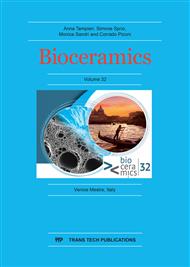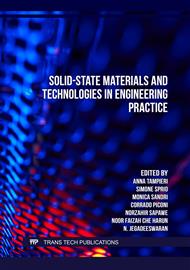p.71
p.83
p.89
p.101
p.107
p.113
p.119
p.131
p.137
Apatite-Graphene and Apatite-Graphene Oxide Nanocomposites: Hybrid Materials with Tailored Biological and Luminescent Properties
Abstract:
Apatite nanocomposites with graphene (G) or graphene oxide (GO) nanoflakes, as well as with related carbonaceous materials, present promising applications in hard tissue engineering, biomedicine, or drug delivery. Different methodologies have been explored in the last years to prepare apatite-based nanocomposites. Sitting drop vapour diffusion (SDVD) methodology induces the heterogeneous nucleation of biomimetic apatite on the reinforcement material, improving biological properties of the nanocomposites. In this work SDVD was used to prepare G-apatite and GO-apatite nanocomposites. Prior to the SDVD experiments, G flakes were obtained by sonication-assisted liquid-phase exfoliation (LPE) using L-Alanine (L-Aln) as dispersing biomolecule, while a commercial aqueous Graphene Oxide (GO) dispersion was used for the nucleation essays in presence of the same biomolecules. A parallel set of nucleation experiments was performed in presence of Tb3+ ions, to endow the nanocomposites of luminescent properties. Characterization by XRD, FTIR, and TEM demonstrated the heterogeneous nucleation of needle-shaped apatite nanocrystals on the surfaces of G and GO flakes. Fluorescence spectroscopy certified the presence of Tb3+ ions in the nanocomposites resulting in luminescent materials which can be used in imaging or theragnostic. Finally, in vitro tests with human mesenchymal stem cells revealed excellent cytocompatibility and cell proliferation in presence of the nanocomposites.
Info:
Periodical:
Pages:
137-141
Citation:
Online since:
December 2022
Keywords:
Price:
Сopyright:
© 2022 Trans Tech Publications Ltd. All Rights Reserved
Share:
Citation:



